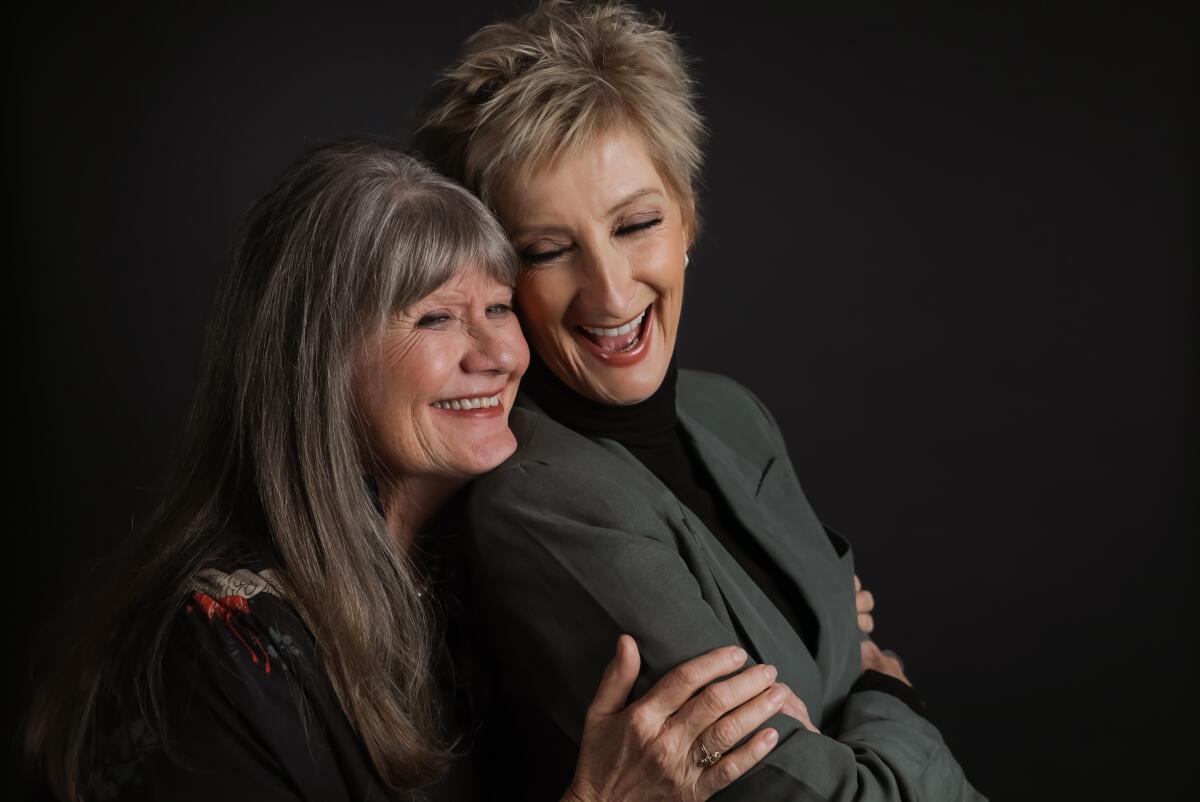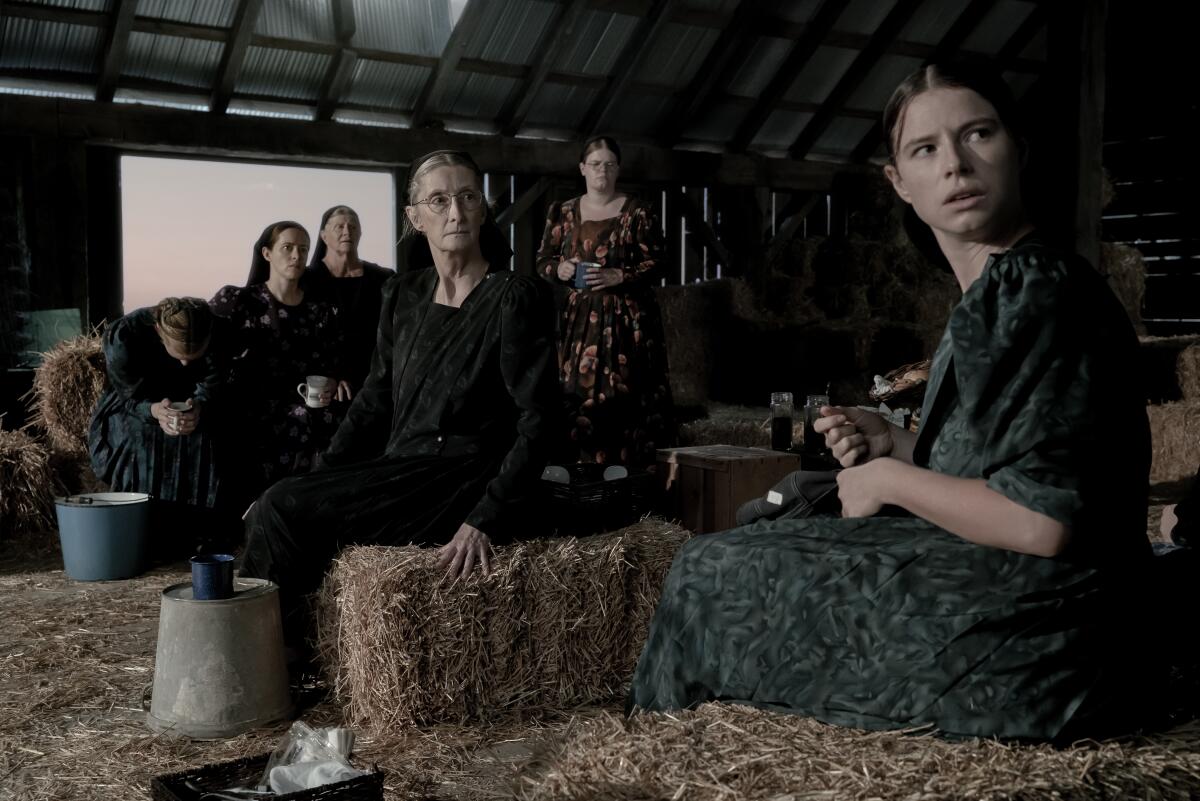Judith Ivey and Sheila McCarthy live the fury, grief and resolve of ‘Women Talking’

- Share via
As “Women Talking” begins, it is discovered that a group of men in an isolated religious colony have drugged and raped the women and girls in the community. The rapists have been arrested; the rest of the men have taken the long journey into town to bail them out, expecting — nay, demanding — that the women forgive them and continue with life as it was. Collectively, the women agree that is not an option. A select number of them gather in the hayloft to decide whether to stay and fight for change, or leave the only world they know, while the audience bears witness to their fury, grief and resolve.
Director Sarah Polley adapted the film from Miriam Toews’ book of the same name, loosely based on a true story. Polley fills the hayloft with an array of stars, including Claire Foy, Rooney Mara, Jessie Buckley, Sheila McCarthy and Judith Ivey.
The film, which opened Christmas week, mercifully never shows a rape scene; the attacks are hinted at as the survivors awaken to blood and pain. “And how powerful it is not to see those scenes, just to see the aftermath,” McCarthy says via Zoom from her home in Toronto. “It’s the conversation that matters, not the actual graphic part. The movie begins in the process of healing, and that’s what it should be.” She and Ivey play the elders of two families, their faith lending a gentle strength to the proceedings.
When Polley first approached McCarthy to play Greta, she voiced concern about the actor’s youthful energy. “I said, ‘I will tamp down my enthusiasm,’” McCarthy recalls, before noting that it’s easy for her to forget she’s 66. “I feel like I’m 8 years old and my underwear is showing, still,” she jokes, her pixie haircut reminiscent of her breakout role in the 1987 indie film “I’ve Heard the Mermaids Singing.” McCarthy says “The lesson for me as Greta was listening and picking my moments to be listened to. Greta also provides the comic relief, if you can say such a thing, and I adored exploring that.”

The shoot took place in Toronto over the summer of 2021. Unlike most productions, “We were on set all day, every day,” McCarthy says. “We all spent three months in that hayloft talking. Boy, oh boy, we had to show up with our A-game every day. This was a very unusual theatrical commitment from all of us. It was like a Broadway run.”
Speaking by phone from her Nantucket home, Ivey agrees. “It’s what I love when I’m acting,” says the two-time Tony winner. “I’ve always kind of struggled with film, because the scenes are so short, then it’s time to move on and you think, did I even have a character?” On this shoot, one 11-page scene took three days and 120 takes. “It was joyous because there were eight, nine, 10 people in it, and we got to do it over and over and over and over again.”
In creating her character, Agata, Ivey says, “I have to give all credit to Sarah Polley — from scene to scene, take to take, moment to moment, her general note to me was: ‘You can just simply do it; you can just simply say it. Make it simpler.’ These women are complex, but they’re not complicated.” She also turned to the memory of her grandmother, a woman who approached life with great enthusiasm.
Ivey has since found herself incorporating some of Agata’s qualities. “I found it rewarding to play somebody who has that kind of patience. It’s very much in my consciousness now as Judy walking around: Am I not being patient? Am I being demanding, am I being critical, am I being judgmental, when I really should just sit back and let it be? It was very revelatory.”
She and McCarthy bonded immediately, “and not just because of our ages, but we’re both from the theater first,” Ivey says. “One day we discovered we had at least 50 people in common.” Adds McCarthy, “I’m so sad she lives so far away from me, because I would be knocking on her door and seeing her every single day of my life if I could. She’s a funny, wonderful, wry person.”
The women had no idea how the film would turn out until they saw it. And then, McCarthy says, “I thought, ‘God, I look 170.’ I had to watch it again to see anybody but myself.” Ivey notes that during the shoot, when “we had to be the plain Janes, with little if any makeup, and our kerchiefs and polyester dresses and socks and sandals, I told Sheila, ‘I don’t know if this is stupid or brave of us,’ and she said, ‘Don’t think about it. When we go to the festivals, we’re going to wear lots of makeup and sparkly dresses.’”
They’ve had plenty of opportunities. “A lot of movies you make, you don’t ever really see anybody again,” Ivey says. “With the success of this film and how welcomed it has been by all these movie festivals — I’ve been to nine of them — you get to see everybody again and again. We were joking that it’s a high school reunion every two or three weeks. I think everybody in the end was a big fan of each other, because we had gone through this very momentous piece together, and you did not want to falter for a second, mostly out of admiration for what everyone was bringing to the table. It’s unfortunate that it’s a rare experience, but how great that it happened, particularly with a piece that said so much.”
McCarthy agrees, ending on a Greta-like note of faith. “It was like we were singing a long hymn.”
More to Read
From the Oscars to the Emmys.
Get the Envelope newsletter for exclusive awards season coverage, behind-the-scenes stories from the Envelope podcast and columnist Glenn Whipp’s must-read analysis.
You may occasionally receive promotional content from the Los Angeles Times.










